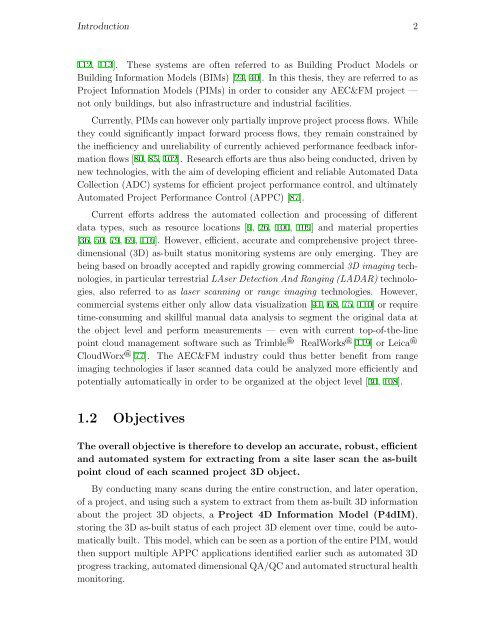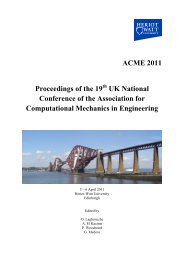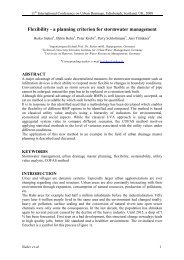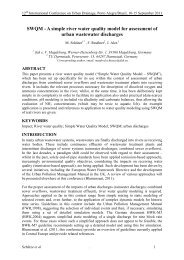PhD Thesis - Automated Recognition of 3D CAD Model Objects in ...
PhD Thesis - Automated Recognition of 3D CAD Model Objects in ...
PhD Thesis - Automated Recognition of 3D CAD Model Objects in ...
Create successful ePaper yourself
Turn your PDF publications into a flip-book with our unique Google optimized e-Paper software.
Introduction 2<br />
112, 113]. These systems are <strong>of</strong>ten referred to as Build<strong>in</strong>g Product <strong>Model</strong>s or<br />
Build<strong>in</strong>g Information <strong>Model</strong>s (BIMs) [24, 40]. In this thesis, they are referred to as<br />
Project Information <strong>Model</strong>s (PIMs) <strong>in</strong> order to consider any AEC&FM project —<br />
not only build<strong>in</strong>gs, but also <strong>in</strong>frastructure and <strong>in</strong>dustrial facilities.<br />
Currently, PIMs can however only partially improve project process flows. While<br />
they could significantly impact forward process flows, they rema<strong>in</strong> constra<strong>in</strong>ed by<br />
the <strong>in</strong>efficiency and unreliability <strong>of</strong> currently achieved performance feedback <strong>in</strong>formation<br />
flows [80, 85, 102]. Research efforts are thus also be<strong>in</strong>g conducted, driven by<br />
new technologies, with the aim <strong>of</strong> develop<strong>in</strong>g efficient and reliable <strong>Automated</strong> Data<br />
Collection (ADC) systems for efficient project performance control, and ultimately<br />
<strong>Automated</strong> Project Performance Control (APPC) [87].<br />
Current efforts address the automated collection and process<strong>in</strong>g <strong>of</strong> different<br />
data types, such as resource locations [9, 26, 100, 109] and material properties<br />
[36, 50, 79, 69, 116]. However, efficient, accurate and comprehensive project threedimensional<br />
(<strong>3D</strong>) as-built status monitor<strong>in</strong>g systems are only emerg<strong>in</strong>g. They are<br />
be<strong>in</strong>g based on broadly accepted and rapidly grow<strong>in</strong>g commercial <strong>3D</strong> imag<strong>in</strong>g technologies,<br />
<strong>in</strong> particular terrestrial LAser Detection And Rang<strong>in</strong>g (LADAR) technologies,<br />
also referred to as laser scann<strong>in</strong>g or range imag<strong>in</strong>g technologies. However,<br />
commercial systems either only allow data visualization [41, 68, 75, 110] or require<br />
time-consum<strong>in</strong>g and skillful manual data analysis to segment the orig<strong>in</strong>al data at<br />
the object level and perform measurements — even with current top-<strong>of</strong>-the-l<strong>in</strong>e<br />
po<strong>in</strong>t cloud management s<strong>of</strong>tware such as Trimble � RealWorks � [119] or Leica �<br />
CloudWorx � [77]. The AEC&FM <strong>in</strong>dustry could thus better benefit from range<br />
imag<strong>in</strong>g technologies if laser scanned data could be analyzed more efficiently and<br />
potentially automatically <strong>in</strong> order to be organized at the object level [30, 108].<br />
1.2 Objectives<br />
The overall objective is therefore to develop an accurate, robust, efficient<br />
and automated system for extract<strong>in</strong>g from a site laser scan the as-built<br />
po<strong>in</strong>t cloud <strong>of</strong> each scanned project <strong>3D</strong> object.<br />
By conduct<strong>in</strong>g many scans dur<strong>in</strong>g the entire construction, and later operation,<br />
<strong>of</strong> a project, and us<strong>in</strong>g such a system to extract from them as-built <strong>3D</strong> <strong>in</strong>formation<br />
about the project <strong>3D</strong> objects, a Project 4D Information <strong>Model</strong> (P4dIM),<br />
stor<strong>in</strong>g the <strong>3D</strong> as-built status <strong>of</strong> each project <strong>3D</strong> element over time, could be automatically<br />
built. This model, which can be seen as a portion <strong>of</strong> the entire PIM, would<br />
then support multiple APPC applications identified earlier such as automated <strong>3D</strong><br />
progress track<strong>in</strong>g, automated dimensional QA/QC and automated structural health<br />
monitor<strong>in</strong>g.













